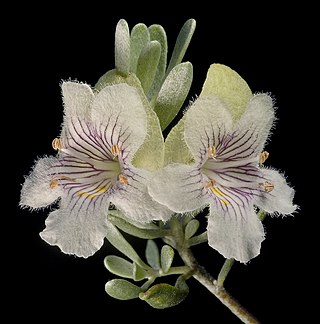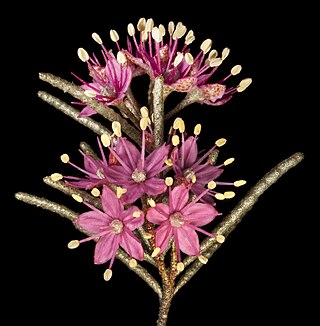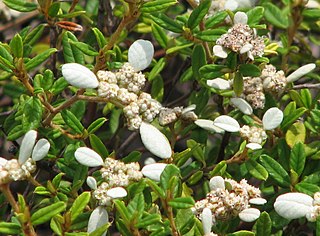
Leptospermum is a genus of shrubs and small trees in the myrtle family Myrtaceae commonly known as tea trees, although this name is sometimes also used for some species of Melaleuca. Most species are endemic to Australia, with the greatest diversity in the south of the continent, but some are native to other parts of the world, including New Zealand and Southeast Asia. Leptospermums all have five conspicuous petals and five groups of stamens which alternate with the petals. There is a single style in the centre of the flower and the fruit is a woody capsule.

Leucopogon is a genus of about 150-160 species of shrubs or small trees in the family Ericaceae, in the section of that family formerly treated as the separate family Epacridaceae. They are native to Australia, New Zealand, New Caledonia, the western Pacific Islands and Malaysia, with the greatest species diversity in the south-west of Western Australia. Plants in this genus have leaves with a few more or less parallel veins, and tube-shaped flowers usually with a white beard inside.

Prostanthera, commonly known as mintbush or mint bush, is a genus of about 100 species of flowering plants in the mint family Lamiaceae, and all are endemic to Australia. Plants are usually shrubs, rarely trees with leaves in opposite pairs. The flowers are arranged in panicles in the leaf axils or on the ends of branchlets. The sepals are joined at the base with two lobes. The petals are usually blue to purple or white, joined in a tube with two "lips", the lower lip with three lobes and the upper lip with two lobes or notched.

Pimelea, commonly known as rice flowers, is a genus of plants belonging to the family Thymelaeaceae. There are about 150 species, including 110 in Australia and 36 in New Zealand.

Olearia, most commonly known as daisy-bush, is a genus of flowering plants belonging to the family Asteraceae, the largest of the flowering plant families in the world. Olearia are found in Australia, New Guinea and New Zealand. The genus includes herbaceous plants, shrubs and small trees. The latter are unusual among the Asteraceae and are called tree daisies in New Zealand. All bear the familiar daisy-like composite flowerheads in white, pink, mauve or purple.

Kunzea is a genus of plants in the family Myrtaceae and is endemic to Australasia. They are shrubs, sometimes small trees and usually have small, crowded, rather aromatic leaves. The flowers are similar to those of plants in the genus Leptospermum but differ in having stamens that are longer than the petals. Most kunzeas are endemic to Western Australia but a few occur in eastern Australia and a few are found in New Zealand. The taxonomy of the genus is not settled and is complicated by the existence of a number of hybrids.

Baeckea is a genus of flowering plants in the myrtle family, Myrtaceae, all but one endemic to Australia. Plants in the genus Baeckea are shrubs or small trees with leaves arranged in opposite pairs, white to deep pink flowers with five sepals and five petals, and five to fifteen stamens that are shorter than the petals.

Homoranthus is a genus of about thirty species of plants in the myrtle family Myrtaceae and all are endemic to Australia. Plants in this genus share similarities with those in both Darwinia and Verticordia. They are shrubs with their leaves arranged in opposite pairs and with flowers appearing either singly or in small groups, usually in upper leaf axils. They are found in Queensland, New South Wales and South Australia. The genus was first described in 1836. None of the species is common nor are they well-known in horticulture.

Pomaderris is a genus of about 80 species of flowering plants in the family Rhamnaceae, the species native to Australia and/or New Zealand. Plants in the genus Pomaderris are usually shrubs, sometimes small trees with simple leaves arranged alternately along the branches and bisexual, woolly-hairy flowers arranged in racemes or panicles. The flowers are usually yellow and often lack petals.

Swainsona is a genus of about 85 species of flowering plants in the family Fabaceae, and is endemic to Australia. Plants in this genus are herbs or subshrubs with imparipinnate leaves and usually purple flowers similar to others in the family.

Cryptandra is a genus of flowering plants family Rhamnaceae and is endemic to Australia. Most plants in the genus Cryptandra are spiny, heath-like shrubs with small, clustered leaves and flowers crowded at the ends of branches, the flowers are usually small, surrounded by brown bracts, and with tube-shaped hypanthium, the petals hooded over the anthers.

Thryptomene is a genus of flowering plants in the family Myrtaceae and is endemic to Australia. Plants in the genus Thryptomene are shrubs with small leaves arranged in opposite pairs and white or pink flowers. About forty-seven species of Thryptomene, occurring in all Australian states and the Northern Territory, have been formally described.

Xanthosia is a genus of flowering plants in the family Apiaceae and is endemic to Australia. It comprises 20 species of shrubs endemic to Australia. Plants in the genus Xanthosia are perennial herbs or small shrubs, the leaves divided, toothed or lobed,, the flowers white, pinkish or pale green and usually arranged in a compound umbel.

Phebalium is a genus of thirty species of shrubs or small trees in the family Rutaceae and is endemic to Australia. The leaves are arranged alternately, simple and often warty, the flowers arranged singly or in umbels on the ends of branchlets or in leaf axils, usually with five sepals, five petals and ten stamens. There are about thirty species and they are found in all Australian states but not in the Northern Territory.

Bossiaea is a genus of about 78 species of flowering plants in the pea family Fabaceae and is endemic to Australia. Plants in this genus often have stems and branches modified as cladodes, simple, often much reduced leaves, flowers with the upper two sepal lobes larger than the lower three, usually orange to yellow petals with reddish markings, and the fruit a more or less flattened pod.

Lasiopetalum, commonly known as velvet bushes, is a genus of about forty-five species of flowering plants in the family Malvaceae, all endemic to Australia.

Spyridium is a genus of about thirty species of flowering plants in the family Rhamnaceae, and is endemic to Australia. Plants in the genus Spyridium are shrubs or subshrubs usually with small leaves, flowers usually in clusters of small composite heads, the individual flowers small and densely woolly-hairy, and the fruit a capsule. Species of Spyridium are found in all Australian states except Queensland.

Styphelia is a genus of shrubs in the family Ericaceae, native from Indo-China through the Pacific to Australia. Most have minute or small leaves with a sharp tip, single, tube-shaped flowers arranged in leaf axils and with the ends of the petals rolled back with hairs in the inside of the tube.

Micromyrtus elobata is a species of flowering plant in the myrtle family, Myrtaceae and is endemic to the south of Western Australia. It is usually an erect shrub with small, narrowly to broadly egg-shaped leaves with the narrower end towards the base, and white flowers 3–5 mm (0.12–0.20 in) in diameter.

Stenanthemum is a genus of flowering plants family Rhamnaceae and is endemic to Australia. Plants in the genus Stenanthemum are small shrubs usually lacking spines. The leaves are arranged alternately along the branches, simple, usually folded in half lengthwise on a short petiole. The flowers are arranged in dense heads, usually on the ends of branches with bracts at the base of the flowers, and there are sometimes whitish floral leaves. The flowers are bisexual, more or less sessile and have five sepals, five petals and a tube-shaped hypanthium, the petals hooded over the stamens. The fruit is a schizocarp containing spotted or mottled seeds.




















